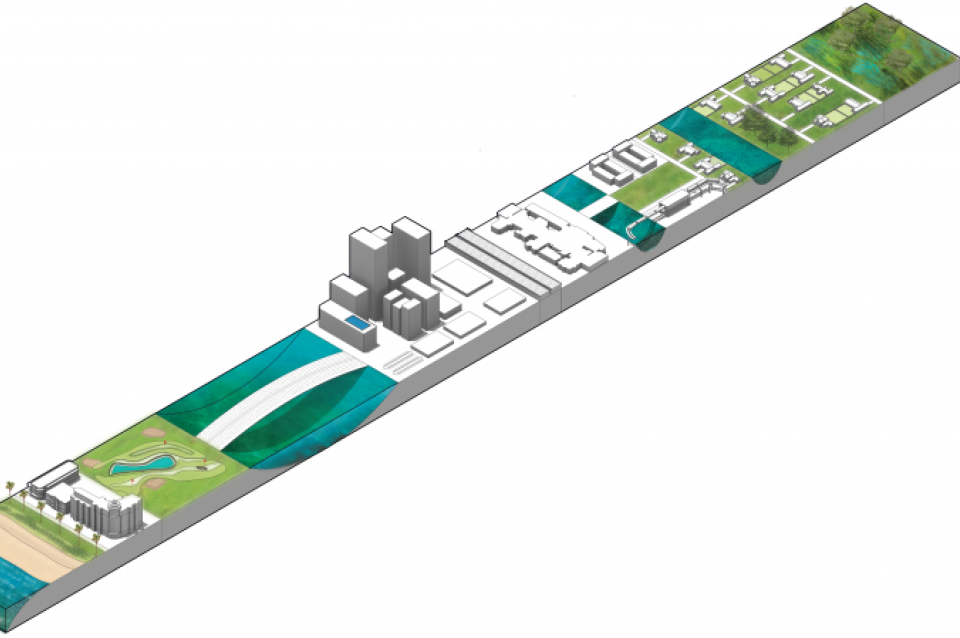April 24, 2017
Field Report: Designing for Resiliency in South Florida

“Before” (above) and “after” (next slide) transects show the locations where projects are being designed and the intended resiliency impact.
Stuart Weitzman School of Design
102 Meyerson Hall
210 South 34th Street
Philadelphia, PA 19104

“Before” (above) and “after” (next slide) transects show the locations where projects are being designed and the intended resiliency impact.
Michael Grant
mrgrant@design.upenn.edu
215.898.2539
City and Regional Planning students Alex Schieferdecker, Kathryn Kramer and Jarred Toups filed this report on designing new relationships with flood infrastructure in South Florida as part of a Spring 2017 travel studio with Associate Professor Stefan Al.
By some metrics, Miami is the world’s most vulnerable city to the effects of climate change and sea-level rise. With over $38 billion in property assets and a population greater than 5 million located less than 3 feet above current sea level, the need to protect the South Florida region is humanitarian and economic. The impacts of climate change are exacerbated by the geologic and geographic features of South Florida. The region sits upon porous limestone, and backs up against the Everglades. Through extreme rain storms, storm surges, high tides, and sea level rise, Miami is under attack by water from the sea, the swamp, the sky, and the ground.
A team of PennDesign students is working to meet this challenge. The final capstone course for the urban design concentration of the Master’s in City and Regional Planning program requires students to complete work in the public realm. This studio is co-taught by Stefan Al, Associate Professor of City and Regional Planning, and Edgar Westerhof, National Director for Flood Risk and Resiliency for ARCADIS, a Dutch design firm specializing in water issues. The mission of the studio is to design solutions for managing water in the Miami region, while also creating healthier and more productive public spaces.
In early February, we traveled to South Florida to explore sites, attend meetings with stakeholders, and lead a design workshop with students from Florida International University. We were inspired by the rich design heritage of South Florida: Miami Beach boasts an impressive collection of historic buildings in Art Deco and “Miami Modern” (MiMo) styles, many of which are vulnerable to the impacts of climate change. In contrast, the Peréz Art Museum, located on the waterfront in Miami, showcases contemporary architecture that deals with the vulnerability of the site and potential threats of climate change. Parking is located on the ground floor beneath the museum, and the gallery space is elevated above near-term sea level threats. The raised elevation of the building provides an opportunity for an open-air, waterfront terraced public space, topped with sitting areas naturally cooled by shade and lush vegetation. Both the historic MiMo and Art Deco District and contemporary Peréz Art Museum offer examples of historic character, local trends, and an inspiring examples of how to design within the Miami context.
The studio team also met with key players in the Miami region’s fight against the rising sea. Miami Beach’s head engineer Bruce Mowery gave the group a tour of Sunset Harbor, one of the most threatened neighborhoods of Miami Beach. It has been the target of investments that are helping raise the streets and critical infrastructure. The newly raised streets create an interesting condition where the sidewalk and the outdoor seating of restaurants are now several feet below the new street grade. Similar to the Peréz Art Museum, this creates opportunities for unique public realm design. In Sunset Harbor there is now space for shaded sidewalk cafés that both engages with the street but is also protected from it. Mowery’s tour allowed the students to see other infrastructure projects including seawalls and new flood pumps. His enthusiasm and progressive view for protecting Miami Beach is an asset to the community. The students time with Mowery showed them that urban design and engineering interventions need to work together to maximize the benefits and protection for climate change.
In an exercise in community engagement, PennDesign students helped lead a Miami resiliency workshop. The event was co-hosted by ARCADIS, the Netherlands Consulate General of Miami, and Florida International University and included lectures and break-out discussion groups. The primary talk was given by Henk Ovink, Special Envoy for International Water Affairs of the Kingdom of the Netherlands, who served on President Barack Obama’s resiliency task force in the aftermath of Superstorm Sandy. Mr. Ovink discussed the challenges Miami is facing and ways to start addressing them, as well as his experiences from travelling the world and advising governments how to work with water and tackle the impacts of climate change. The break-out discussion groups paired climate change experts with students to discuss the challenges and solutions for infrastructure, policy and governance, the economy, and communities as each of theses topics reacts and responds to sea-level rise differently in Miami.
After our return to Philadelphia we began working on design interventions that aim to not only make the city more resilient, but also to create high quality public spaces in South Florida.